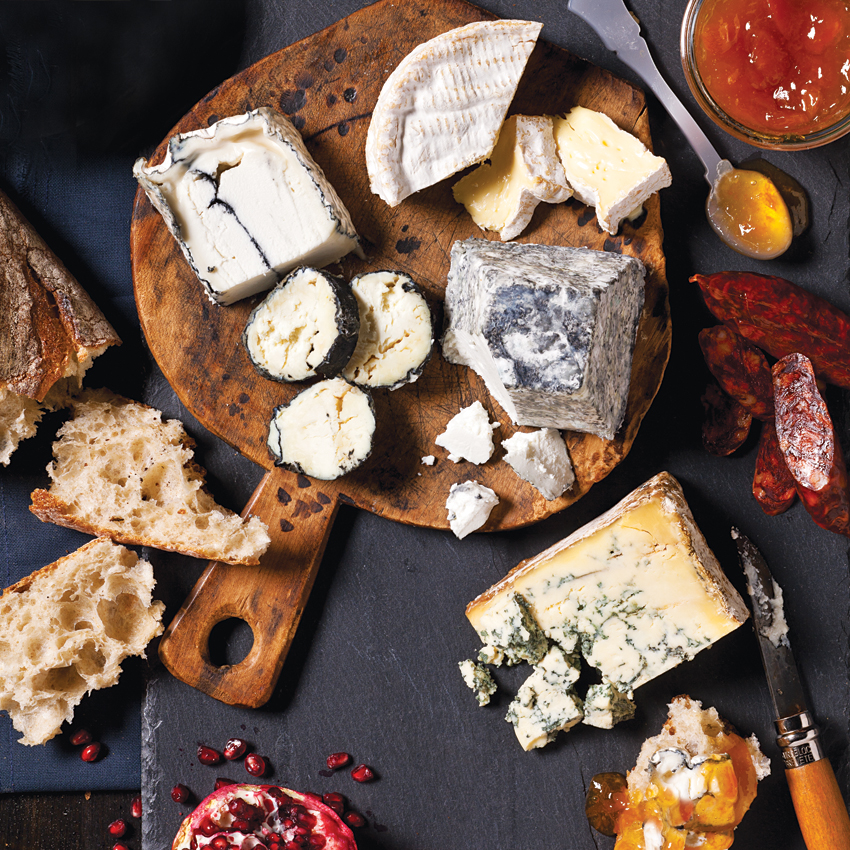Expert Advice

Clockwise from top, Our Daily Bread wooden board, from $43, Lake’s Edge goat’s milk cheese, $26 per pound, Camembert Au Calvados cow’s milk cheese, $14 per wheel, June Taylor’s Seville orange marmalade, $16, mini chorizo, $2 each, Colston Bassett Stilton cow’s milk cheese, $28 per pound, Valencay goat’s milk cheese, $13 each, Sainte Maure Belgique goat’s milk cheese, $11 each, and Iggy’s country baguette, $2.75 each, all Formaggio Kitchen; spoon, stylist’s own. (Photograph by Dave Bradley. Food Styling by Rowena Day. Prop Styling by Lauren Niles.)
Build a Gourmet Cheese Board
When Ihsan Gurdal, co-owner of Cambridge’s Formaggio Kitchen, isn’t searching for exotic cheeses in Geneva or the Pyrenees with his wife, Valerie, he’s in New England sourcing local fromage. “We really don’t have to go anywhere else because we have so much going on right here,” he says, “and we can still maintain our high standards.”
CHEESE
Gurdal buys goat cheeses from Blue Ledge Farm, in Salisbury, and Sage Farm, in Stowe, Vermont. He also finds exceptional varieties at Jasper Hill Farm, in Greensboro, Vermont. Down at Connecticut’s Cato Corner Farm, Gurdal picks up a washed-rind variety known as “Hooligan.”
BOARDS
When setting out a cheese spread, Gurdal prefers rustic boards made from reclaimed materials. Our Daily Bread Board, for instance, turns sunken wooden beams and fallen trees into functional art, while Brooklyn Slate Company uses black and red shards of slate from an upstate New York quarry to make boards and coasters, as well as other kitchen goods. And this fall Bruce Graham, of Grahamscape, will begin making boards exclusively for Formaggio Kitchen from the dozens of trees destroyed by last year’s winter storms on his own Westport property.
KNIVES
Gurdal selects knives based on their feel, design, and function. “Times have changed and people want all these gizmos,” he says. “They think bigger is better, but it’s not.” His go-to folding knife is an Opinel, which features a wooden handle and a carbon-steel blade. Couteau des Sorgues, meanwhile, makes an excellent spreader and cutter that can be opened and closed with one hand. Gurdal often relies on his knife from Coltelleria Saladini, a co-op of knife makers in Scarperia, Italy (the medieval village is known as the “town of knife-making”).
STORAGE
Gurdal ages his shops’ cheese wheels in underground caves, where temperatures remain cool and the flow of oxygen is limited. Once cheese is cut, however, it doesn’t store well, so Gurdal recommends buying only as much as you will use in the near future, then keeping it wrapped in cheese paper (on the windowsill during the winter, or in the crisper drawer in the fridge). Another short-term option: Store Brie and Camembert on a piece of marble covered by a cloche.
PRO FINISH
Gurdal likes to use garnishes produced in the same regions as the cheeses. He enjoys his locally sourced slices and spreads with honey-roasted almonds and cashew crunch from Fastachi, in Watertown; pure raw honey from Carlisle Honey, in Carlisle; and preserves from Bonnie’s Jams, based in Lynn.
Insider Tips
• One spoonful of local honey builds your immunity to the region’s allergens.
• When enjoying a cheese board, taste each piece separately, then the condiment, then marry them together on your palate.
Get It!
Petite cloche stand, $40, Sur La Table.

Photograph by Alex Gagne


